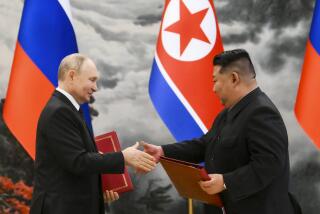CIA Documents Denounce Agency’s Korea War Tactics
- Share via
WASHINGTON — Nearly all Korean agents sent behind enemy lines by the CIA during the Korean War were either killed or doubled as spies for the Communists, causing the agency to conclude that its use of American-trained loyalists was “morally reprehensible,” according to declassified records.
The judgment is significant not only for the internal conflicts it exposes but also because the CIA has never publicly acknowledged the scope or outcome of its covert operations during the war.
The records indicate that the CIA sent thousands of agents into North Korea during the 1950-53 war, which broke out just three years after the agency was created. Their missions ranged from intelligence-gathering to establishing “escape and evasion,” or E&E;, networks to rescue downed U.S. pilots.
“E&E; operations as conducted by CIA in Korea were not only ineffective but probably morally reprehensible in that the number of lives lost and the amount of time and treasure expended was enormously disproportionate to attainments therefrom,” a July 1973 CIA historical review said, quoting from a January 1954 report by the Korea branch chief at CIA headquarters.
Early in the war, CIA espionage efforts scored some notable successes, but most of the agency’s attempts to penetrate North Korea once peace talks began in the summer of 1951 failed, the records show.
Portions of the secret 1973 review and other records were declassified at the request of author Michael E. Haas, whose book “In the Devil’s Shadow” was published in March by the Naval Institute Press. The book provides a detailed description of CIA and U.S. military operations behind North Korean lines. The CIA provided Associated Press with copies of the material after AP inquired about the book’s disclosures.
Some Americans were sent on CIA missions behind enemy lines, but most agents were South Koreans or anti-Communist North Koreans forced to flee when China entered the war in October 1950.
Haas said the agency refused to release an exact count of agents it sent into North Korea during the war, often aboard Air Force planes. But he cited a partially declassified CIA document that states that “thousands of personnel” were airdropped into the country from June 1950 until the truce in July 1953.
The U.S. Army, Air Force and Navy also sent untold hundreds of Koreans on such missions. Few agents made it back alive, especially in the last two years of the war. Their inherently dangerous missions were made even more hazardous by bureaucratic conflict and confusion that combined to produce what Haas called “behind-the-lines chaos.”
A senior agency official, whose identity was not disclosed, warned in September 1952 that agents sent north to set up escape and evasion networks “had almost no chance of success.” He predicted that they would be captured “and that the majority of them would be doubled,” to work for the enemy.
More to Read
Sign up for Essential California
The most important California stories and recommendations in your inbox every morning.
You may occasionally receive promotional content from the Los Angeles Times.













